初中英语词汇教学的研究
- 格式:doc
- 大小:38.00 KB
- 文档页数:9
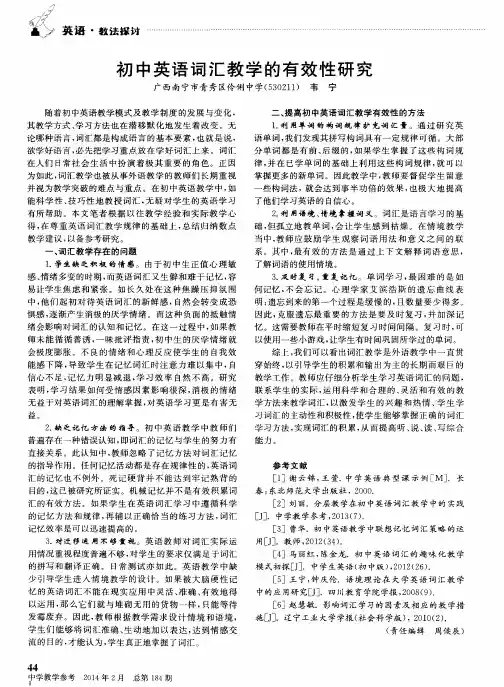
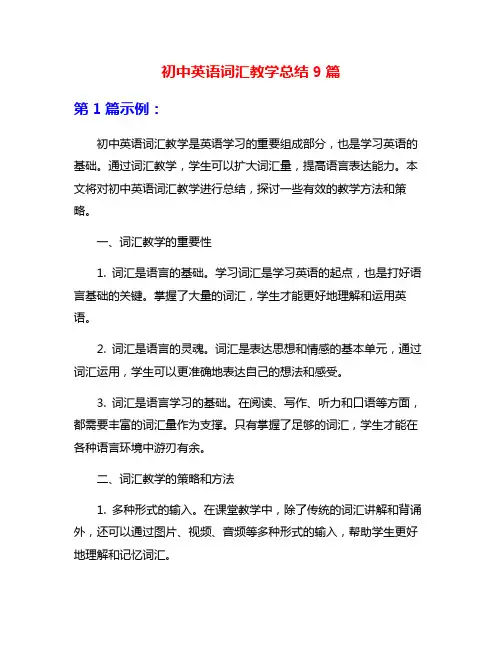
初中英语词汇教学总结9篇第1篇示例:初中英语词汇教学是英语学习的重要组成部分,也是学习英语的基础。
通过词汇教学,学生可以扩大词汇量,提高语言表达能力。
本文将对初中英语词汇教学进行总结,探讨一些有效的教学方法和策略。
一、词汇教学的重要性1. 词汇是语言的基础。
学习词汇是学习英语的起点,也是打好语言基础的关键。
掌握了大量的词汇,学生才能更好地理解和运用英语。
2. 词汇是语言的灵魂。
词汇是表达思想和情感的基本单元,通过词汇运用,学生可以更准确地表达自己的想法和感受。
3. 词汇是语言学习的基础。
在阅读、写作、听力和口语等方面,都需要丰富的词汇量作为支撑。
只有掌握了足够的词汇,学生才能在各种语言环境中游刃有余。
二、词汇教学的策略和方法1. 多种形式的输入。
在课堂教学中,除了传统的词汇讲解和背诵外,还可以通过图片、视频、音频等多种形式的输入,帮助学生更好地理解和记忆词汇。
2. 语境化教学。
将词汇教学与语境相结合,让学生在真实的语言环境中学习和应用词汇,这样学生能更快地掌握词汇的意义和用法。
通过对话、阅读、写作等活动,让学生在不同情景中运用所学词汇。
3. 多种记忆方式。
利用联想、记忆技巧等方法,帮助学生记忆词汇。
通过单词卡、词根词缀等方式,让学生在记忆词汇的同时提升记忆效果。
4. 多种练习形式。
词汇教学不仅要注重记忆,还要注重运用。
通过填空、选择、造句等多种练习形式,帮助学生巩固所学词汇,提高语言能力。
5. 激发学生学习兴趣。
通过游戏、竞赛等形式,激发学生学习英语的兴趣,让学生在轻松愉快的氛围中学习词汇,提高学习积极性。
1. 定期测试。
通过定期测试的方式,检测学生对词汇的掌握情况,及时发现问题和不足,帮助学生针对性地加强练习。
2. 词汇积累记录。
要求学生建立起自己的词汇积累表,每周记录新学习的单词及其意义和用法,及时复习并巩固记忆。
3. 课堂表现评价。
通过课堂问答、作业、小组合作等形式,评价学生在词汇教学中的表现,以及学生的学习态度和参与度。
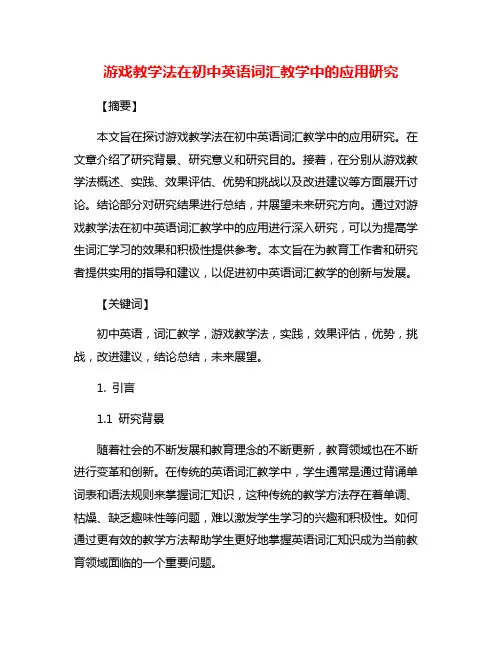
游戏教学法在初中英语词汇教学中的应用研究【摘要】本文旨在探讨游戏教学法在初中英语词汇教学中的应用研究。
在文章介绍了研究背景、研究意义和研究目的。
接着,在分别从游戏教学法概述、实践、效果评估、优势和挑战以及改进建议等方面展开讨论。
结论部分对研究结果进行总结,并展望未来研究方向。
通过对游戏教学法在初中英语词汇教学中的应用进行深入研究,可以为提高学生词汇学习的效果和积极性提供参考。
本文旨在为教育工作者和研究者提供实用的指导和建议,以促进初中英语词汇教学的创新与发展。
【关键词】初中英语,词汇教学,游戏教学法,实践,效果评估,优势,挑战,改进建议,结论总结,未来展望。
1. 引言1.1 研究背景随着社会的不断发展和教育理念的不断更新,教育领域也在不断进行变革和创新。
在传统的英语词汇教学中,学生通常是通过背诵单词表和语法规则来掌握词汇知识,这种传统的教学方法存在着单调、枯燥、缺乏趣味性等问题,难以激发学生学习的兴趣和积极性。
如何通过更有效的教学方法帮助学生更好地掌握英语词汇知识成为当前教育领域面临的一个重要问题。
1.2 研究意义初中英语词汇教学是英语学习的基础,对学生打下良好的词汇基础至关重要。
而游戏教学法在初中英语词汇教学中的应用研究具有重要意义。
游戏教学法可以激发学生学习英语的兴趣,增强他们对学习的积极性,提高学习效果。
通过游戏教学法,可以让学生在愉快的氛围中学习,降低学习压力,增强学生的学习主动性和参与度。
游戏教学法还可以帮助学生更好地理解和记忆词汇,促进语言技能的全面发展。
研究游戏教学法在初中英语词汇教学中的应用,有助于拓展教学方法,丰富教学手段,提高教学质量。
通过深入研究游戏教学法在词汇教学中的实践经验和效果评估,可以为教师提供更多有效的教学策略和方法,为优化英语教学教育提供借鉴和参考。
探究游戏教学法在初中英语词汇教学中的应用意义重大,对提高英语教育的教学质量和效果具有积极的促进作用。
1.3 研究目的研究目的是为了探讨游戏教学法在初中英语词汇教学中的应用效果,以及分析其在词汇学习中的具体影响。
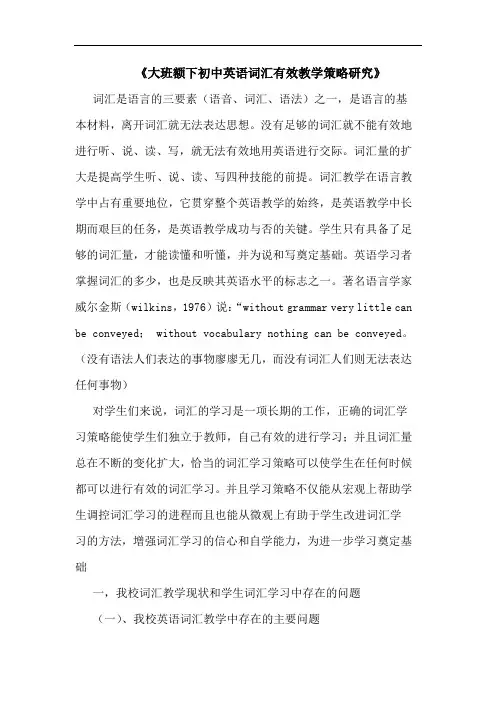
《大班额下初中英语词汇有效教学策略研究》词汇是语言的三要素(语音、词汇、语法)之一,是语言的基本材料,离开词汇就无法表达思想。
没有足够的词汇就不能有效地进行听、说、读、写,就无法有效地用英语进行交际。
词汇量的扩大是提高学生听、说、读、写四种技能的前提。
词汇教学在语言教学中占有重要地位,它贯穿整个英语教学的始终,是英语教学中长期而艰巨的任务,是英语教学成功与否的关键。
学生只有具备了足够的词汇量,才能读懂和听懂,并为说和写奠定基础。
英语学习者掌握词汇的多少,也是反映其英语水平的标志之一。
著名语言学家威尔金斯(wilkins,1976)说:“without grammar very little can be conveyed; without vocabulary nothing can be conveyed。
(没有语法人们表达的事物廖廖无几,而没有词汇人们则无法表达任何事物)对学生们来说,词汇的学习是一项长期的工作,正确的词汇学习策略能使学生们独立于教师,自己有效的进行学习;并且词汇量总在不断的变化扩大,恰当的词汇学习策略可以使学生在任何时候都可以进行有效的词汇学习。
并且学习策略不仅能从宏观上帮助学生调控词汇学习的进程而且也能从微观上有助于学生改进词汇学习的方法,增强词汇学习的信心和自学能力,为进一步学习奠定基础一,我校词汇教学现状和学生词汇学习中存在的问题(一)、我校英语词汇教学中存在的主要问题第一、没有做好小学初中英语教学的衔接和学生学习方式的转变,导致一些学生“入不了门”,部分小学英语学得不错的学生不能适应中学老师的教学,从而使其英语学习渐渐变得空难,丧失了学习兴趣。
第二、我校班额大,班级成员过多,教师与学生之间相互沟通的机会就减少,情感联系就会减弱,教师难以照顾到每一个学生,这样就会使部分学生感到被教师与集体冷落,产生消极情绪。
同时班级过大,成员过多,学生的个体差异明显,不同的需求导致心理冲突,影响课堂气氛,形成消极,甚至是抵触情绪,使课堂教学不能得以顺利、有效的开展。
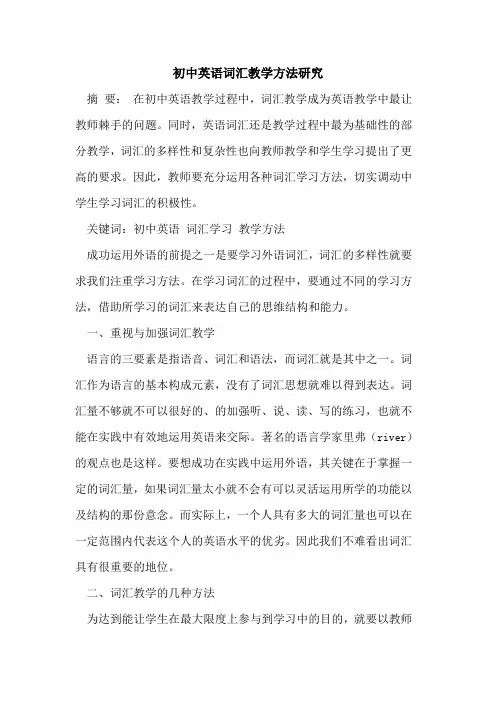
初中英语词汇教学方法研究摘要:在初中英语教学过程中,词汇教学成为英语教学中最让教师棘手的问题。
同时,英语词汇还是教学过程中最为基础性的部分教学,词汇的多样性和复杂性也向教师教学和学生学习提出了更高的要求。
因此,教师要充分运用各种词汇学习方法,切实调动中学生学习词汇的积极性。
关键词:初中英语词汇学习教学方法成功运用外语的前提之一是要学习外语词汇,词汇的多样性就要求我们注重学习方法。
在学习词汇的过程中,要通过不同的学习方法,借助所学习的词汇来表达自己的思维结构和能力。
一、重视与加强词汇教学语言的三要素是指语音、词汇和语法,而词汇就是其中之一。
词汇作为语言的基本构成元素,没有了词汇思想就难以得到表达。
词汇量不够就不可以很好的、的加强听、说、读、写的练习,也就不能在实践中有效地运用英语来交际。
著名的语言学家里弗(river)的观点也是这样。
要想成功在实践中运用外语,其关键在于掌握一定的词汇量,如果词汇量太小就不会有可以灵活运用所学的功能以及结构的那份意念。
而实际上,一个人具有多大的词汇量也可以在一定范围内代表这个人的英语水平的优劣。
因此我们不难看出词汇具有很重要的地位。
二、词汇教学的几种方法为达到能让学生在最大限度上参与到学习中的目的,就要以教师作为主导,学生作为主体,从而使学生可以渐渐培养出积极学习的观念。
积极学习外语的本质是:要确保教师的指导贯穿整个教学的过程,树立学生自己是主人翁的外语学习的观点。
全面的激发学生学习的主观能动性,踊跃参加各种需要耳听、动脑、眼看、动手的类似学习活动,同时,充分掌握到自辩、自理和自治以及自学几个方面的能力。
掌握以及运用知识技能的能力,使智力和情意得到发展,进而使得学生能够实现德、智、美、劳、体以及自由个性的全方位的发展状态。
别利雅也夫的观点表明:由心理学的角度出发,词语不仅仅是一种存在于感知以及理解写和说的过程之中的复合性的刺激,而且是人将自己思想的表达于书面或者口头的时候具有相同复杂的结构之反应。
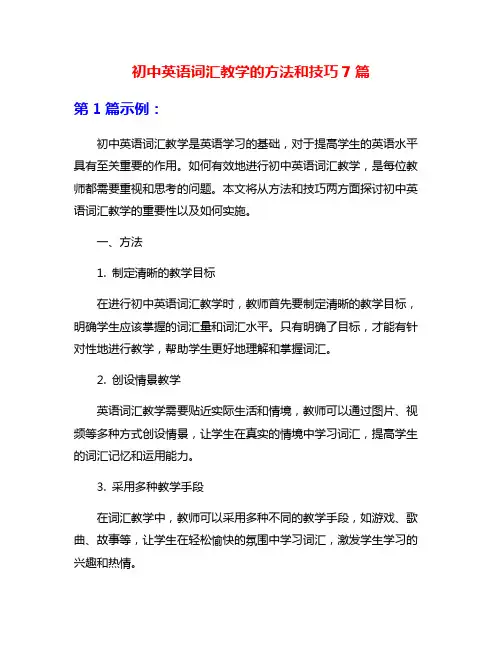
初中英语词汇教学的方法和技巧7篇第1篇示例:初中英语词汇教学是英语学习的基础,对于提高学生的英语水平具有至关重要的作用。
如何有效地进行初中英语词汇教学,是每位教师都需要重视和思考的问题。
本文将从方法和技巧两方面探讨初中英语词汇教学的重要性以及如何实施。
一、方法1. 制定清晰的教学目标在进行初中英语词汇教学时,教师首先要制定清晰的教学目标,明确学生应该掌握的词汇量和词汇水平。
只有明确了目标,才能有针对性地进行教学,帮助学生更好地理解和掌握词汇。
2. 创设情景教学英语词汇教学需要贴近实际生活和情境,教师可以通过图片、视频等多种方式创设情景,让学生在真实的情境中学习词汇,提高学生的词汇记忆和运用能力。
3. 采用多种教学手段在词汇教学中,教师可以采用多种不同的教学手段,如游戏、歌曲、故事等,让学生在轻松愉快的氛围中学习词汇,激发学生学习的兴趣和热情。
4. 强化词汇记忆对于一些比较难记的词汇,可以采用反复朗读、写作、造句等方法,帮助学生强化词汇的记忆和应用,提高学生的词汇运用能力。
5. 引导学生自主学习在词汇教学中,教师应该引导学生自主学习,让学生养成独立学习的习惯和能力,激发学生的学习兴趣和动力。
二、技巧1. 制定合理的学习计划对于初中生来说,时间管理非常重要,教师可以帮助学生制定合理的学习计划,分配适当的时间学习词汇,让学生在有限的时间内获取最大的学习效果。
2. 注重词汇的积累和运用在教学过程中,教师要注重词汇的积累和运用,让学生在不断的积累中提高词汇量,同时要引导学生在实际的交流和写作中灵活运用所学词汇,提高词汇的应用能力。
3. 鼓励学生多读多写阅读和写作是提高词汇水平的重要途径,教师可以鼓励学生多读英语原著,多写英语作文,从中不断积累和运用词汇,提高英语表达能力。
4. 反馈和评估在词汇教学中,教师应该及时给予学生反馈和评估,帮助学生发现自己的不足和问题,并及时进行调整和改进,提高学生的学习效果。
初中英语词汇教学是英语学习的基础,对于提高学生的英语水平至关重要。
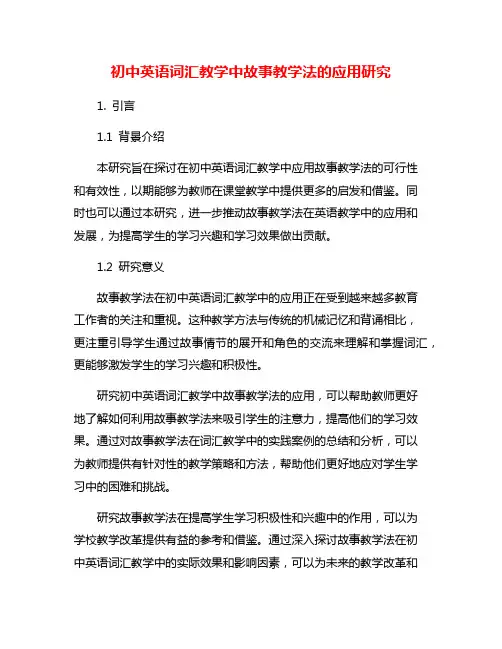
初中英语词汇教学中故事教学法的应用研究1. 引言1.1 背景介绍本研究旨在探讨在初中英语词汇教学中应用故事教学法的可行性和有效性,以期能够为教师在课堂教学中提供更多的启发和借鉴。
同时也可以通过本研究,进一步推动故事教学法在英语教学中的应用和发展,为提高学生的学习兴趣和学习效果做出贡献。
1.2 研究意义故事教学法在初中英语词汇教学中的应用正在受到越来越多教育工作者的关注和重视。
这种教学方法与传统的机械记忆和背诵相比,更注重引导学生通过故事情节的展开和角色的交流来理解和掌握词汇,更能够激发学生的学习兴趣和积极性。
研究初中英语词汇教学中故事教学法的应用,可以帮助教师更好地了解如何利用故事教学法来吸引学生的注意力,提高他们的学习效果。
通过对故事教学法在词汇教学中的实践案例的总结和分析,可以为教师提供有针对性的教学策略和方法,帮助他们更好地应对学生学习中的困难和挑战。
研究故事教学法在提高学生学习积极性和兴趣中的作用,可以为学校教学改革提供有益的参考和借鉴。
通过深入探讨故事教学法在初中英语词汇教学中的实际效果和影响因素,可以为未来的教学改革和教学实践提供科学的理论依据和实践经验。
研究初中英语词汇教学中故事教学法的应用具有重要的实践和理论意义。
1.3 研究目的本研究旨在探讨初中英语词汇教学中故事教学法的应用,并对其效果进行评价。
具体目的包括:1. 分析故事教学法在初中英语词汇教学中的实际运用情况,了解教师和学生对该教学法的态度和看法;2. 探讨故事教学法在提高学生学习积极性和兴趣方面的作用,探讨其对学生学习效果的影响;3. 结合实践案例,总结故事教学法在英语词汇教学中的优势和不足,为今后的教学实践提供参考和建议;4. 探讨故事教学法的发展趋势,展望未来研究方向,为进一步深入研究和推广故事教学法提供理论支持。
通过本研究,旨在为提高初中英语词汇教学质量和学生学习效果提供有益的借鉴和启示。
2. 正文2.1 故事教学法概述故事教学法是一种通过讲故事的方式来进行教学的方法。
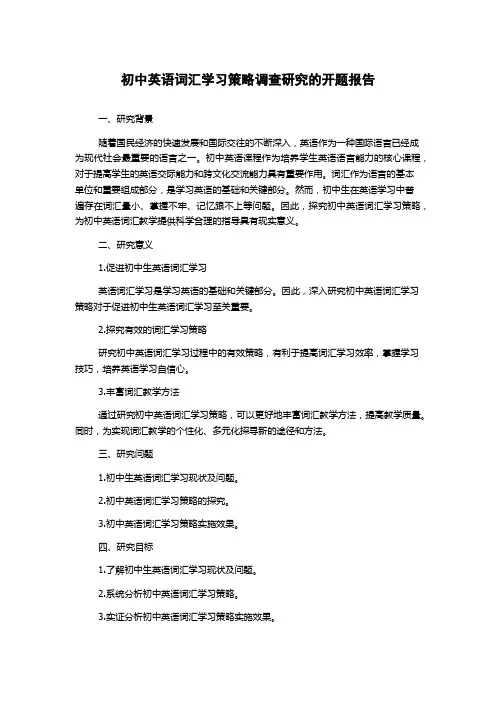
初中英语词汇学习策略调查研究的开题报告一、研究背景随着国民经济的快速发展和国际交往的不断深入,英语作为一种国际语言已经成为现代社会最重要的语言之一。
初中英语课程作为培养学生英语语言能力的核心课程,对于提高学生的英语交际能力和跨文化交流能力具有重要作用。
词汇作为语言的基本单位和重要组成部分,是学习英语的基础和关键部分。
然而,初中生在英语学习中普遍存在词汇量小、掌握不牢、记忆跟不上等问题。
因此,探究初中英语词汇学习策略,为初中英语词汇教学提供科学合理的指导具有现实意义。
二、研究意义1.促进初中生英语词汇学习英语词汇学习是学习英语的基础和关键部分。
因此,深入研究初中英语词汇学习策略对于促进初中生英语词汇学习至关重要。
2.探究有效的词汇学习策略研究初中英语词汇学习过程中的有效策略,有利于提高词汇学习效率,掌握学习技巧,培养英语学习自信心。
3.丰富词汇教学方法通过研究初中英语词汇学习策略,可以更好地丰富词汇教学方法,提高教学质量。
同时,为实现词汇教学的个性化、多元化探寻新的途径和方法。
三、研究问题1.初中生英语词汇学习现状及问题。
2.初中英语词汇学习策略的探究。
3.初中英语词汇学习策略实施效果。
四、研究目标1.了解初中生英语词汇学习现状及问题。
2.系统分析初中英语词汇学习策略。
3.实证分析初中英语词汇学习策略实施效果。
4.探究初中英语词汇学习策略的可行性和优越性。
五、研究方法1.问卷调查法通过制定调查问卷,收集初中英语教师、学生和家长的意见和建议,了解学生在词汇学习过程中的实际需求和问题。
2.文献资料法收集与初中英语词汇学习策略相关的国内外文献资料,了解初中英语词汇学习策略的研究现状和发展趋势。
3.实证研究法通过实验和案例分析等方法,验证初中英语词汇学习策略的实施效果和可行性。
六、研究内容1.初中生英语词汇学习现状及问题的调查分析。
2.初中英语词汇学习策略的探究(1)基于认知心理学的初中英语词汇学习策略。
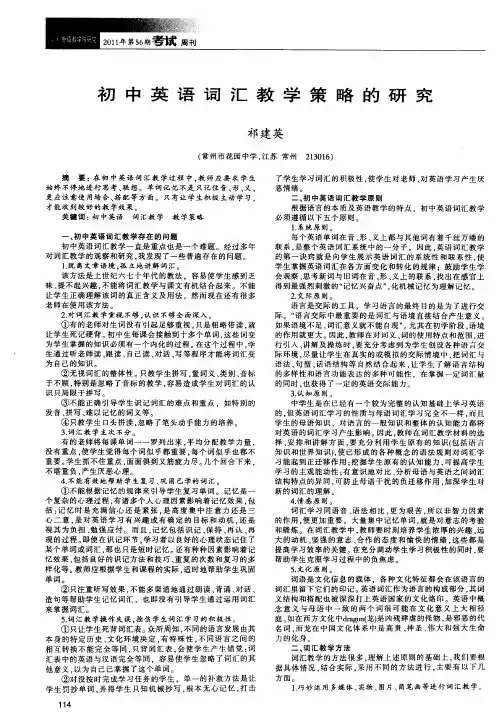
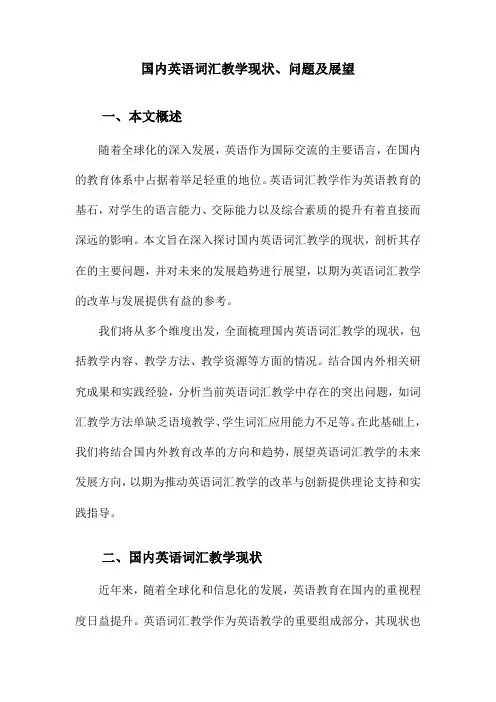
国内英语词汇教学现状、问题及展望一、本文概述随着全球化的深入发展,英语作为国际交流的主要语言,在国内的教育体系中占据着举足轻重的地位。
英语词汇教学作为英语教育的基石,对学生的语言能力、交际能力以及综合素质的提升有着直接而深远的影响。
本文旨在深入探讨国内英语词汇教学的现状,剖析其存在的主要问题,并对未来的发展趋势进行展望,以期为英语词汇教学的改革与发展提供有益的参考。
我们将从多个维度出发,全面梳理国内英语词汇教学的现状,包括教学内容、教学方法、教学资源等方面的情况。
结合国内外相关研究成果和实践经验,分析当前英语词汇教学中存在的突出问题,如词汇教学方法单缺乏语境教学、学生词汇应用能力不足等。
在此基础上,我们将结合国内外教育改革的方向和趋势,展望英语词汇教学的未来发展方向,以期为推动英语词汇教学的改革与创新提供理论支持和实践指导。
二、国内英语词汇教学现状近年来,随着全球化和信息化的发展,英语教育在国内的重视程度日益提升。
英语词汇教学作为英语教学的重要组成部分,其现状也呈现出一些显著的特点。
目前,国内英语词汇教学主要依赖于课堂教学。
教师通常在课堂上进行词汇的讲解、示范和练习,学生则通过听讲、记忆和模仿来学习英语词汇。
这种教学模式在一定程度上能够帮助学生掌握一定数量的词汇,但也存在一些问题。
课堂教学往往注重词汇的记忆而忽视了词汇的实际运用。
学生在课堂上学习了词汇后,很少有机会在实际生活中运用这些词汇,导致词汇的记忆效果不佳。
英语词汇教学的内容和方法相对单一。
很多教师只是简单地按照课本上的词汇表进行讲解,缺乏灵活性和趣味性,难以激发学生的学习兴趣。
英语词汇教学还面临着学生个体差异的挑战。
不同学生的英语基础水平、学习兴趣和学习策略都有所不同,但很多教师并没有针对这些差异进行教学设计,导致一些学生在词汇学习上感到困难。
尽管如此,也有一些教师在英语词汇教学方面进行了积极的探索和实践。
例如,他们尝试将词汇教学与学生的生活实际相结合,通过创设真实的语境来帮助学生理解和记忆词汇;他们还利用多媒体和网络资源,丰富教学内容和手段,提高词汇教学的趣味性和实效性。
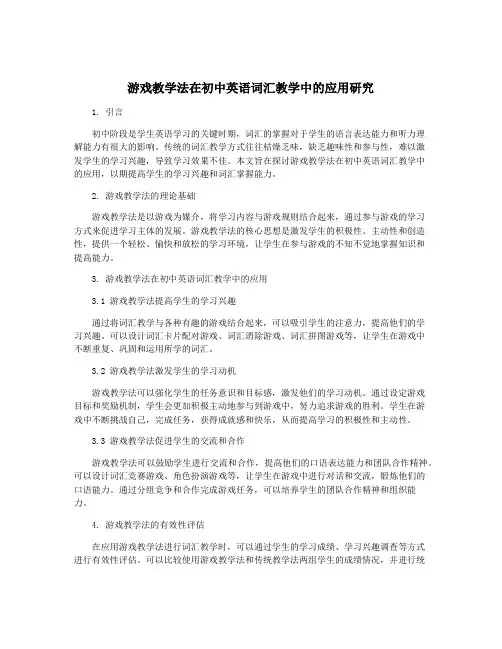
游戏教学法在初中英语词汇教学中的应用研究1. 引言初中阶段是学生英语学习的关键时期,词汇的掌握对于学生的语言表达能力和听力理解能力有很大的影响。
传统的词汇教学方式往往枯燥乏味,缺乏趣味性和参与性,难以激发学生的学习兴趣,导致学习效果不佳。
本文旨在探讨游戏教学法在初中英语词汇教学中的应用,以期提高学生的学习兴趣和词汇掌握能力。
2. 游戏教学法的理论基础游戏教学法是以游戏为媒介,将学习内容与游戏规则结合起来,通过参与游戏的学习方式来促进学习主体的发展。
游戏教学法的核心思想是激发学生的积极性、主动性和创造性,提供一个轻松、愉快和放松的学习环境,让学生在参与游戏的不知不觉地掌握知识和提高能力。
3. 游戏教学法在初中英语词汇教学中的应用3.1 游戏教学法提高学生的学习兴趣通过将词汇教学与各种有趣的游戏结合起来,可以吸引学生的注意力,提高他们的学习兴趣。
可以设计词汇卡片配对游戏、词汇消除游戏、词汇拼图游戏等,让学生在游戏中不断重复、巩固和运用所学的词汇。
3.2 游戏教学法激发学生的学习动机游戏教学法可以强化学生的任务意识和目标感,激发他们的学习动机。
通过设定游戏目标和奖励机制,学生会更加积极主动地参与到游戏中,努力追求游戏的胜利。
学生在游戏中不断挑战自己,完成任务,获得成就感和快乐,从而提高学习的积极性和主动性。
3.3 游戏教学法促进学生的交流和合作游戏教学法可以鼓励学生进行交流和合作,提高他们的口语表达能力和团队合作精神。
可以设计词汇竞赛游戏、角色扮演游戏等,让学生在游戏中进行对话和交流,锻炼他们的口语能力。
通过分组竞争和合作完成游戏任务,可以培养学生的团队合作精神和组织能力。
4. 游戏教学法的有效性评估在应用游戏教学法进行词汇教学时,可以通过学生的学习成绩、学习兴趣调查等方式进行有效性评估。
可以比较使用游戏教学法和传统教学法两组学生的成绩情况,并进行统计分析,判断游戏教学法的效果是否显著。
可以进行问卷调查,了解学生对于游戏教学法的评价和意见,从而进一步优化教学设计和提高教学效果。
初中英语词汇教学的探究在初中英语教学中,英语单词是英语学习的基础,贯穿于英语学习过程的始终。
学生如果想学好英语,就必须掌握好英语词汇;好多学生之所以英语学习不好,在很大程度上就归因于英语词汇的掌握程度不高,因此,英语词汇教学在英语教学中有着举足轻重的地位。
本文针对初中英语词汇教学提出了一些建议,希望对大家有所启示。
一、加强学生听力训练,让学生能够正确发音“哑巴英语”的现象在初中生学习中是很普遍的现象,之所以会出现这种状况,原因之一是因为听得不够仔细,无法掌握英语单词的正确读音。
初中英语老师在教授英语单词时要先让学生仔细听、反复听,注意听标准的读音,注意掌握正确的发音技巧,并反复读单词,读的过程也是记忆的过程。
此外,还要进行听力小训练,在学生熟悉每个单词的基础上,听录音写单词,并在此基础上判断出每个英语单词的中文含义。
长此以往,不仅能够使学生很好地掌握英语的正确发音,而且能够训练学生的听力能力,为以后的学习打下了良好的基础。
二、反对死记硬背,注意单词组成的规律初中英语词汇学习中最忌讳的就是死记硬背,死记硬背不能够快速有效地学习单词,反而容易把多个词汇弄混淆。
因此,在初中英语教学过程中要掌握英语词汇的构成规律,变死记硬背为灵活记忆,这不仅有效地提高了学习效率,而且培养了学生的自主学习能力。
(一)掌握英语词汇的构成规律,按照音节来记忆词汇初中学习阶段,学生们的英语词汇掌握量会越来越大,单纯的死记硬背已经无法满足初中生的学习需要。
在初中英语教学过程中,教师首先要讲解清楚英语词汇的构成规律,告诉学生单词与单词、字母与字母之间的联系。
其次要把英语音标的学习放在重要位置,音标好比汉语里的拼音,是学习汉语的基础。
英语单词在发音的时候,不是一个字母一个字母地来发音的,而是几个字母几个字母地拼起来发音的,因此英语单词叫“拼音文字”,几个拼起来发音的字母组合叫一个“音节”。
音节有开音节、闭音节、半开音节之分,不同的音节里,要选择字母的不同发音。
初中英语词汇分层教学的实践与研究词汇是语言的三要素之一,是语言的基本材料,离开词汇就无法表达思想。
没有足够的词汇就不能有效地进行听、说、读、写,就无法有效地用英语进行交际。
词汇量的扩大是提高学生听、说、读、写四种技能的前提。
词汇教学在语言教学中占有重要地位,它贯穿整个英语教学,是英语教学中长期而艰巨的任务,是英语教学成功与否的关键。
我们要在各方面仔细、周到、务实、科学、智慧地做些工作,尽量提高词汇教学的效率和质量。
一、在施教过程中,应遵循“三个基本原则”,以达到教师的激励与学生的发展有机地结合1.同步、异步教学相结合原则。
2.学生知识形成发展规律与心理认知规律相结合原则。
3.激励性原则。
二、实施步骤包括四个方面1.分层:创设条件,动态分层每一个学生都具有不同的素质和生活环境,经过小学六年、初中两年的学习,学生之间各方面的差异显而易见,所以,我们英语教师在备课时应考虑学生各方面的情况,为不同层次的学生制定相应的英语词汇学习目标,以便使学生找到自己的坐标点。
为此笔者通过问卷调查、两次词汇测试的平均成绩和学习可能性水平将实验班学生分为a、b、c三个层次,比例分别占19%、56%、25%。
一般来说,单词测试成绩好、学习兴趣浓、学习主动、接受快的学生属于a层;单词测试成绩中等、学习情绪不够稳定或能力一般但学习较勤奋的学生属于b层;单词测试成绩较差、学习困难大,消极厌学或顽皮不学的学生属于c层。
把学生进行动态分层,就是让学生较为客观地知道自己目前所处的层次水平和近期(当前单元)的英语词汇学习的目标。
如果要更上一层楼,则要进一步掌握哪些词汇知识;反之,如果未达本层,则要先巩固上一层的哪些更基础的词汇知识。
使学生了解自己的英语词汇学习目标,有助于优秀生明白自己英语词汇学习应学到什么程度才算优秀,中等生明确如何才算英语词汇达标,后进生树立学习英语词汇的自信心。
2.制定各层次的目标:科学合理,“跳一跳够得着”英语词汇分层次教学的关键在于教师能否根据每个层次的学生的不同特点给予不同的指导,提出不同的要求。
5.1 Major Findings (50)5.2 Pedagogical Implications (51)5.3 Limitations of the Study (52)5.4 Suggestions for Further Research (52)References (54)Appendix A (59)Appendix B (60)Appendix C (62)Appendix D (64)Appendix E (65)由于它的基础性,词汇是外语学习中必不可少的一部分。
然而,我们发现许多中国学生对英语词汇学习不感兴趣甚至对词汇感到畏惧。
越来越多的英语老师发现也许学生会记住很多单词和短语,但是他们并不能把这些单词短语正确地用到合适的地方。
基于这种情况,本论文欲探索一种更有效实际的词汇教学方法,以提高学生对词汇的学习兴趣并且帮助学生提高词汇运用能力。
在中国,对英语而言,初中是真正的打基础阶段,所以本文选初一学生作为研究对象。
本文主要探索研究语境教学法应用于初中英语词汇教学的有效性。
初一两个班级被分别选为实验班和控制班。
这两个班的入学成绩相近且使用相同的教材和练习册。
在十一周的实验期间,实验班通过语境教学法教单词,而控制班则按照传统方法教词汇。
另外,在此期间,运用了调查问卷,词汇测试和访谈作为实验工具。
在实验前和实验后分别在实验班和控制班进行词汇测试,但是实验前后只在实验班分发调查问卷调查学生词汇学习态度变化。
实验后针对学生对词汇的学习态度和对语境教学法的态度等相关问题在实验班随机选取九个学生进行访谈。
经统计学软件SPSS13.0数据分析显示实验班的成绩远高于控制班的成绩,并且发现实验班学生对词汇的学习兴趣实验后也比实验前大大提高。
据此,作者得出语境教学法能够提高学生词汇运用能力,也能提高学生对词汇的学习态度的结论。
最后论文结尾作者针对语境教学法和词汇学习给出了相应的建议。
关键词:语境教学法;英语词汇教学;初中V ocabulary is an essential part of foreign language learning because of its fundamental position. However, it is found that many students in China are not interested in learning English vocabulary. And more and more English teachers realize that students may remember a lot of words or idioms, but they cannot use them appropriately. Based on this situation, this thesis aims to explore a method which is more effective and practical in vocabulary teaching. The purpose is to arouse students‟ interests towards v ocabulary and help them improve their competence of applying vocabulary. Junior high school is the real fundamental phase for English learning in China, so students of Grade One in junior high school were chosen as the subjects.The study mainly explores the effectiveness of context-based approach in the application of English vocabulary in junior high school. Two classes which had nearly the same average scores in the school entrance examination were chosen as experimental class and control class. The same textbook and workbook were adopted in the two classes.During the eleven-week experiment, vocabulary was taught through context-based approach in experimental class, while traditional method was adopted in control class. Besides, questionnaires, vocabulary tests and interviews were adopted as research instruments. V ocabulary tests were given to both classes before and after experiment, while at the same time the same questionnaire on students‟ attitudes towards vocabulary was handed out to the experimental class only. After experiment, nine students in the experimental class were interviewed to obtain more details about students‟ attitudes towards vocabulary and context-based approach. After analyzing the data via statistics software SPSS 13.0, it proved thatthe performance of the experimental class was much better than that of control class. Meanwhile, the students of the experimental class showed more interests in learning vocabulary than before. Therefore, the researcher draws the conclusion that context-based approach can highly improve the students‟ vocabulary performance and improve their attitudes towards vocabulary as well. At last suggestions concerning the context-based approach and vocabulary learning are given in the end of the thesis.Key words: context-based approach, English vocabulary teaching, junior high schoolTable 4.1The Results of Pretest (35)Table 4.2Independent Sample Test of Pretest (36)Table 4.3 T he Results of the Posttest (36)Table 4.4 Independent Sample Test of Posttest (37)Table 4.5C omparison on the Pretest and Posttest of Experimental Class (37)Table 4.6 Wilcoxon Signed Ranks Test (38)Table 4.7T est Statistics of the Two Tests (38)Figure 2.1Classification of Context (10)Figure 4.1 Results on the Students‟ Interests in V ocabulary (39)Figure 4.2 Results on Students‟ Cognition on V ocabulary Learning (40)Figure 4.3Results on Students‟ Cognition on Linguistic Context (40)Figure 4.4 Results on Students‟ Cognition on Cultural Context (41)Figure 4.5Results on Students‟ Cognition on Situational Context (41)Figure 4.6Results on Students‟ Behavior of V ocabulary Reciting Every Day (42)Figure 4.7Results on Students‟ Behavior of V ocabul aries Not in Exam (43)Figure 4.8Results on Students‟ Behavior of V ocabulary Learning in Class (43)Figure 4.9Results on Students‟ Behavior of V ocabulary Learning after Class (44)Figure 4.10Results on Students‟ Behavior of V ocabulary Learning in Daily Life (44)Chapter 1 Introduction1.1 Background of the StudyThere is no doubt that vocabulary plays an important role in English teaching and learning. V ocabulary to a language is what bricks to a building. Without vocabulary, language would not exist. There are three basic elements in a language: vocabulary, sound and grammar. V ocabulary is the uppermost one as it is the carrier of sound and grammar. As Wilkins (1972) states: “Without grammar little thing can be conveyed, without vocabulary, nothing can be conveyed” (p. 111).In a manner of speaking, vocabulary is an important standard to judge a learner‟s English level. Without enough vocabulary, people cannot go on with the basic skills of listening, speaking, reading, writing and translating. In the process of English learning, broadening vocabulary is a basic task. However, we can often hear the complaint of English learners that even though they spend a lot of time and energy on vocabulary, there is little effectiveness. So how vocabulary is taught has been the focus of the teachers. For junior high school students, a good teacher of English is very important. A good teacher should have an effective method to arouse the students‟ interests in English, especially vocabulary.Recent years, there have emerged many teaching methods. Context-based approach has been studied. Related studies conducted in colleges and senior high schools are more and better, while those in junior high schools are not that good. However, we can usually find that junior high school students feel difficult to understand the meaning in different contexts, let alone asking them to use the words correctly in the context. Most of the English teachers often sparetoo much time on explaining the usage of the new words, such as giving related phrases, finding their opposite words or similar words. And the teachers tend to adopt rather simplex method to examine the learning results. But it is such a big burden for students to remember or spell so many words correctly, not to mention using the words appropriately. Junior high school is the fundamental phase in a student‟s English learning process. If the students cannot form a good learning habit at the beginning, they will feel frustrated and even desperate on vocabulary in the future. This study aims to explore the use of context-based approach in vocabulary teaching to arouse the students‟ interests in learning vocabulary.1.2 Significance of the StudyThe meaning of a word is decided by its context, as only when the word appears with another word or words together composing a unified element, it can be precisely understood. There is an outstanding feature in English that one word usually has many different meanings. The word lists in the current English textbook usually present lots of word classes, and some of its corresponding Chinese meanings for the students to memorize, which confuses the students a lot and worsen their burden. So when teaching vocabulary, the teachers should present its context so that the students know how to use it appropriately. Through questionnaire and interview, this thesis aims to further explore the effect of applying context-based approach in vocabulary teaching in junior high school. Through the research to vocabulary context, the way to English vocabulary teaching will be broaden. In practical, firstly this thesis will make an attempt to study context-based approach and apply this new approach into practical teaching in a relaxing atmosphere. Secondly, through a period of experiment, this study tries to supply theoretical andpractical support to future study and teaching.1.3 Overall Structure of the StudyThere are five chapters in this study. In Chapter One, the researcher makes a general introduction to the study. It describes the background of the study, which includes the importance of vocabulary teaching and the present situation of vocabulary teaching in junior high school, the significance as well as the overall structure of the study.Chapter Two is a literature review that provides theoretical support for the thesis. First, it introduces related concepts of context and context-based approach put forward by many different scholars. After that, it reviews different methods of vocabulary teaching. At last, previous study of context theory on vocabulary teaching is introduced abroad and at home.Chapter Three is a presentation of research methodology and experiment procedure carried out in this study. After proposing research questions and introducing research subjects, the researcher introduces research instruments one by one. Then she elaborates the teaching procedure.Chapter Four is a report on the experiment results by presenting the quantitative analyses. Through analyzing the results of the questionnaire, the interview and the tests, the researcher discusses the influences of the context-based approach on students‟ vocabulary performance and their interests in vocabulary.In the last chapter, the researcher makes a conclusion on the major findings and the pedagogical implications, and points out the limitations of the study. Furthermore, the researcher gives some suggestions for the future research.Chapter 2 Literature Review2.1 Context and Context-based ApproachIn this section, the researcher will make an overview of context and context-based approach. The definition of context and context-based approach will be given. The classification of context and the role it plays in vocabulary teaching will be presented as well.2.1.1 Definition of ContextIt is difficult to give an exact definition of context that makes all scholars satisfactory. It is an abstract concept. The term “context” can be used in many different areas, such as philosophy, linguistics, psychology and theory of communication. In linguistics, different scholars define context in different way.There are also two meanings of context according to Oxford Advanced Learner’s English-Chinese Dictionary: 1) the words that come just before and after a word, phrase or statement and help you to understand its meaning. 2) the situation in which something happens and that helps you to understand it (2004, p. 361). In general, the first meaning is used in a narrow sense and is known as linguistic context. And the second one is used in a broad sense and is usually called non-linguistic context such as situation and culture.According to the general viewpoints recorded by most literature, the concept of context is first put forward by Malinowski (1923). He first points out “context of situation” in the appendix to the book The Meaning of Meaning written by Ogden& Richards (1923). The experience in Trobriand when he made an experiment on the primitive tribes‟ language makes him realize that one person has to understand the whole cultural setting in which the word or sentence is used, ifhe wants to understand the meaning of the word or sentence. He argues “the utterance has no meaning except in the context of situation” (p. 307). Ten years later, Malinowski (1935) states “the real understanding of wor ds is always ultimately derived from active experience of those aspects of reality to which the words belong”. He also extends the notion of context from context of situation to cultural context. Malinowski leads a new way to study language pragmatically and contextually. His study on context broadens our eyes of the language. However, Malinowski‟s theory has its limitations. He notices the extra-linguistic factors but ignores the inter-linguistic factors. In addition, he does not mention the components of context of situation or context of culture.Firth (1957) thinks that the context of situation not only includes the context of human activity which is going on at the moment but also the entire cultural setting and the personal history of the participants. He puts forward the idea that one has to take into consideration of the situational context and linguistic context at the same time when analyzing a typical context of situation (Hu, 2006). He is the first person who analyzes language from the angle of context and lists a model. The model covers both of the situational context and the linguistic context in his Papers in Linguistics: the relevant features of the participants; the relevant topics; the effects of the verbal action (Firth, 1957). Firth (1957) goes much further than Malinowski (1935). He notices both the inter-linguistic factors and the extra-linguistic factors. His research is more comprehensive than that of Malinowski (1935).Enlightened by Firth‟s context of situation, Halliday (1964) puts f orward the term “register”. By way of using this term, a variety of languages can be distinguished. In order to describe how the context influences the meanings of language, Halliday (1964) classifies registerinto three parts: field of discourse, tenor of discourse, and mode of discourse. The change of any of the three parts has direct influence to that of register, which means that any part of them changes may result in a new register. Halliday‟s register theory has a great influence on the research of context, and in some extent develops and completes the context theory.American scholar Fishman (1965) puts forward the notion of “domain” as the social situation restrained by common rules. It includes time, place, identity and theme which the discourse occurred. Fishman and Halliday (1964) both confirm the influence and function of language environment on language use even though their research angels and terminologies are different.Hymes (1972) considers that context is constituted of eight components which we can call it S-P-E-A-K-I-N-G model: setting and scene, participant, ends, art characteristics, key, instrumentalities, norms and genre. By which, he means that in order to speak a language correctly, one needs not only learn its vocabulary and grammar, but also the context in which words are used. He holds the opinion that people should have the competence of speaking appropriately in a certain time, place and occasion. That is usually called “communicative competence”. This kind of communicative compe tence is formed by the interaction between people and society environment. What people say need not only conform to the semantic rules but also adapt with the language environment. Hymes‟s research further develops the context theory and raises it into a certain higher level.Rumelhart (1977) thinks that context is “the total environment in which a word appears” (p.56). As the new word interacts with other words which are before or after it, the reader can obtain its meaning from the context.Leech (1983) argues that context is the background knowledge which is shared by speakers and listeners, and it helps the listeners understand the speakers‟ specific utterances.Goodman (1986) regards context as “information that reduces uncertainty about the elements of a text, their meanings, and the meaning of the text as a whole” (p. 58).According to Coady and Nation (1988), context is morphological, syntactic and discourse information in a given text, and it can be described and classified in terms of general features.The above is the research of context by the scholars abroad from different angles. All of them consider that context exists objectively and it has been there before communication. We can call these views as traditional context or static context.The dynamic viewpoint of context argues that context itself is at the same time under construction and creation. Therefore, context has dynamic feature. In order to make the communication smooth, the two sides of conversation keep constructing and creating new context. In this process, context is constantly being created and changed. But the construction is not aimless but within the scope of background knowledge shared by the two sides.One of the representatives of dynamic context theory, Wilson (1986) defines context as “not simply the preceding linguistic text, or the environment in which the utterance takes place, but the set of assumptions brought to bear in arriving at the intended interpretation” (p, 442). The set of assumptions may be “dra wn from the preceding text, or from observation of the speaker and what is going on in the immediate environment” (ibid), and they may also be “drawn from cultural or scientific knowledge, common-sense assumptions”, and more generally, “any item of shared or idiosyncratic information that the hearer has access to at the time” (ibid).Verschueren (1987) puts forward a linguistic adaption theory. He thinks that a languageuser is always making choices during communication. Verschueren (1987) divides context into two types: communicative context and linguistic context. As to the former one, Verschueren claims that it includes language users, the social world, the mental world and the physical world. Language users not only include the speakers and the hearers, all those people who are related to the content of conversation are also included. Since they may influence the choices made in the generation and comprehension of meaning (Verschueren, 2000). As to the latter one, linguistic context is defined as the co-text in a strict sense.Mey (2001) states “context is a dynamic, not a static concept. It is to be as the continually changing surroundings, in the widest sense, that enable the participants in the communication process to interact, and in which the linguistic expression of their interaction become intelligible” (p. 40). In his opinion, a dynamic context means the environment which changes and develops according to the interaction. Mey (2001) also makes a difference between grammatical view and use-oriented view of language. The linguistic factors are purely grammatical form in terms of the former view; while the latter view focuses on the language use so that context is different among different individuals or groups.We can say that linguistic adaption theory explains the characteristic of language use. The context in this theory is a process of generation or construction. This is a progress compared with traditional context theory.To sum up, from the description of context above, we may draw a conclusion and get a simplified definition of context:Context is an aggregation of all the factors that are related with the internal and external language environment involved in the process of language communication.2.1.2 The Classification of ContextAs discussed in Section 2.1.1, Malinowski (1923) divides context into three categories: context of utterance, context of situation and context of culture. Firth (1957) classifies it into linguistic context and situational context. Halliday (1964) categorizes context into linguistic context and non-linguistic context. He subdivides linguistic context into intratextual context and intertextual context, and non-linguistic context into situational context and cultural context. Verschueren (1987) thinks that there are two types of context: communicative context and linguistic context.Domestic researchers hold similar views on the classification of context. According to Wang (1983), context includes subjective context and objective context. He Zhaoxiong (1989) assumes that context falls into two kinds of knowledge: inner-linguistic and extra-linguistic knowledge. Inner-linguistic covers knowledge on verbal context and the use of language. Extra-linguistic knowledge includes knowledge of situation, background and cognitive knowledge.According to Hu (1997), there are three types of context: linguistic context, which is linguistic environment; situational context, which is the surrounding language the situation in which an utterance is produced; and culture context, which is the speaker‟s own social culture and customs. He Ziran (1997) thinks that context includes linguistic context, social context and cognitive context. Zhang (1999) divides context into the linguistic context and extra-linguistic context.In summary, based on the above discussion on the classification of context, we classify context into linguistic context and non-linguistic context. Linguistic context is subdivided intolexical context, grammatical context and verbal context. Non-linguistic context can be subdivided into situational context and cultural context. In order to make it clear, the figure below is produced.Lexical contextLinguistic context Grammatical contextVerbal contextContext Situational contextNon-linguistic context Cultural contextFigure 2.1 Classification of contextSince the study aims to explore the effect of applying context in vocabulary teaching, the researcher will conduct the experiment based on this structure.zkq 201511252.1.2.1 Linguistic contextLinguistic context is the linguistic setting a word lies in.The setting refers to the surroundings of a word, like words, clauses and sentences, and a paragraph, a chapter or even an entire book may also be included. To some extent, we may conclude that the meaning of a word lies in the words, phrases and sentences around it. As the explanation above, linguistic context can be classified into lexical context, grammatical context and verbal context.Lexical context means the lexical items which are combined with a polysemous word (Zhang, 1987). Lexical context is also known as colloc ation. Firth (1957) claims “each word when used in a new context is a new word” (p.190). Take the word “hold” as an example.a)It takes three men to hold him down (to prevent sb. from moving)b)Please try to hold in your anger (to not express)c)Hold on and don‟t let it go until I say so (to keep holding)d)I hold on t o my mother‟s arm tightly (the action of holding sth.)From these sentences, the polysemous word hold has different meanings when collocating with different words. We cannot tell the precise meaning of the word without other lexical items.Grammatical context is the syntactical structure in which a word may appear. It is also called as syntactical context. Although morphology is usually viewed as part of the system of syntax, morphological rules and syntactic rules are both called grammatical rules. Thus, grammatical context includes morphological rules and syntactic rules together. When the root combined with different affixes, the meaning of a word or even the part of speech will change correspondently. For instance, read-reader, appear-disappear. As we all know that, the word “book” has different meanings in accordance with its part of speech. For example,zkq 20151125a)I bought a book yesterday (a set of printed pages fastened inside a cover)b)My brother will book the ticket tomorrow (to order)From this example we can see that morphological context can change the word meaning and the part of speech.When the word “get” is followed by an object, it means “obtain”. For example, “I got a job in this company”. However, when it is used before an adjective, it means “become”. For instance, “My sister got angry when she saw her living room a mess”. So we can see that the meaning of a word varies when it is put in different syntactic structures.Verbal context can refer to the sentence, the passage or even the text in which a word appears. It sometimes may occur that if we want to know what a word refers to, we have to read what comes before or after it to understand the background material better. Therefore, we can saythat sometimes the meaning of a word relies on the verbal context.2.1.2.2 The Non-linguistic ContextBesides linguistic context, some extra-linguistic factors may also influence the meaning of a word. These extra-linguistic factors contain time, place, transmission mode, people, culture and other non-linguistic backgrounds. These are known as non-linguistic context. Non-linguistic context can be divided into situational context and cultural context.Situational context is the actual situation in which a word, a phrase or a sentence occurs. It does not refer to all the bits and pieces of the material environment such as might appear if we had an audio and video recording of a speech event with all the sights and sounds surrounding the utterances, but refers to those features which are relevant to the speech that is taking place (Halliday, 1987). Situational context involves objective factors, and subjective factors. Objectivezkq 20151125factors include the participants (their age, gender, their social status, education, feelings, etc.), the happenings (time and place), the topic of discourse, the medium of communication and the relationship between the participants. Subjective factors include the author‟s viewpoints, his common sense, his self-cultivation, etc. All of these factors can influence the meaning. For example, talking in the classroom as a teacher is different from talking in the family as a mother. Any discourse of language is bound up tightly with its context of situation and different kinds of situation require us to handle the language in a different way.Cultural context is the entire cultural setting a word, a phrase or a sentence, occurs in. It includes religious traditions, history, politics, economic, cognitive patterns, cultural values and so on. Language is a part of culture and lies in a high position in spreading it. As there are diverse cultures, so there are diverse languages. A word belongs to a language system andlanguage itself is a part of its culture, thus the word meaning is determined by its culture.2.1.3 Context-based ApproachContext-based approach is an approach that abides by and makes use of context theory to organize teaching. Context-based approach has the characteristic of authenticity, associability and conditionality (Liao, 2000).Authenticity means that class is social and communication is authentic. Students are put to the authentic environment and take part in all kinds of language activities as a social member, such as shopping, having dinner in a restaurant, asking for road.Associability means that context-based approach can drive students to make associative thinking. Context-based approach makes students to absorb and apply language knowledge in communicative environment, and this kind of environment helps students to remember thezkq 20151125associative clues, such as, occasion, person, details, which are supplied by the language knowledge. So that it is easier for students to have a long term memory.Conditionality means the context will in common have some restrictive function to the content of language activity, the choice of word and the structure of sentence. For example, in a shopping market, the content of the conversation between the salesclerks and buyers can be anticipated ahead of time mostly. They are nothing more than what to buy, price, size, color, etc.According to Liao (2000), context-based approach is usually operated through three stages. The first stage is introduction, which means introducing new knowledge. The second stage is drills and practice. Once the students get to know and understand the new knowledge, the teachers should organize students to do meaningful drills to train the students‟ skills of listening, speaking, reading and writing. The third stage is application, which means to make use of thenew knowledge flexibly. Understanding the usage of knowledge and doing drills mechanically can simply train the skills of listening, speaking, reading and writing rather than the communicative competence. The third step is a necessity if the four skills being transformed into communicative competence. It means the teachers should create conditions and make chances for students, and put them in a communicative environment to make use of knowledge learned and express their thoughts freely. The aims of context-based approach are to train students‟ application competence, their four basic skills and communicative competence through the three stages (Liao, 2000).The teaching procedure of this study is mainly based on these three stages. The researcher only made some adjustments.2.1.4 The Roles of Context in Vocabulary Teachingzkq 20151125Many scholars and researchers have emphasized the roles of context in vocabulary teaching and learning. Hymes (1972) introduces it in word interpretation from two aspects. On one hand, a certain context can confine the interpretation; on the other hand, context can give stress on the proper interpretation conveyed by the words. So the meaning of a word may vary greatly in different context. In other words, it is the objective context and the interpreter‟s cognitive context that confirm the meaning of a word. Generally, there are four roles of context in vocabulary teaching: eliminating the ambiguity, clearing up fuzzy concept, identifying deixis and completing meaning in ellipsis.First, eliminating the ambiguity. When the meaning of a sentence, a phrase or a word has more than two or more meanings, there will be ambiguity. Each word when used in a new context is a new word (Firth, 1957). It is very common that if lacking of context, many words。
初中英语词汇情境教学研究摘要:英语语境教学法是指通过模拟真实的语言环境,创设英语学习的语言氛围,激发学生潜能,倡导学生体验、参与、合作与交流,提高学生的综合语言运用能力的一种教学形式。
通过联系实际探讨教学策略,旨在提高英语词汇的教学效果。
关键词:初中英语;词汇;情境教学词汇教学是初中英语教学中非常重要的环节。
在真实的或者模拟真实的情境中进行听、说、读、写、译等各项活动,学生才能真正地掌握、巩固和扩大词汇量,才能合理、准确地使用所学词汇,语言交流才能得以更好的实现。
一、初中英语词汇教学的现状1.重结果,轻过程词汇是英语学习的基础。
因此,教师非常重视词汇教学,可是很多教师只重结果,不重过程。
有的教师教词汇,完全照搬词典,非常枯燥乏味;有的教师只领着学生反复读,将背诵单词留给学生课后完成。
这种教学方法的误区是,直接导致学生对词汇学习的茫然,只知道机械记忆,但很快就会忘记。
长此以往,学生的词汇少之又少,只能记住最近学的几个单词,以前学的都忘得干干净净。
2.重词义,轻情境这是目前英语词汇教学中存在的最大问题。
词汇教学包括教授词汇的读音规则、词义、词类、构词法,以及习惯用语和固定搭配等。
目前的初中英语词汇教学,往往是就词论词,教师只注重词汇形式和意义的讲解,无形中将词汇学习从语篇、语境和交际中分离出来,孤立地就词的发音及含义进行教学。
学生也渐渐感到记忆过程的枯燥乏味,从而失去对词汇学习的积极性。
二、英语词汇情境教学的优越性1.有助于形象记忆英语的词汇千变万化,如果教师能够在备课阶段做好充分的准备,或是在平时注意观察和积累,在讲解词汇时,根据单词的特点,创设出有效的语境,就能够引导学生从单调枯燥的机械记忆转变成为丰富生动的形象记忆。
这有助于发展学生的思维能力和想象力,进而提高词汇记忆的效率,调动学生记忆词汇的积极性。
2.有助于准确理解词义一个词组在词典里是孤立的,但一旦用于具体的语境中,它就与其他词汇构成了一个有机编码系统,和特定的语境相关联。
初中英语教学当中关于英语词汇教学的研究摘要:目前初中英语词汇的教学中潜在一些基本问题,下面我们按照英语的词汇的基本原则,分析、讨论、讲解学生在学习中存在的问题,比如对词汇没有积极性、不能高效率的掌握词汇等问题,从而提高英语词汇的教学水平。
关键词:英语词汇学习态度语境联想法英语作为现代必须掌握的语言,学习应该有一定的技巧。
学习一门语言最重要的是词汇。
英语的词汇是全世界最多的词汇量。
如何学好这门语言,是学生的困扰,同时也是教师教学中头痛的一样难题。
下面我们就如何提高记词汇的效率这一课题进行讨论。
一、英语词汇的重要性语言的三要素包括语音、词汇、语法,词汇是学习语言的基本要求,没有了词汇就无法表达准确的意思。
没有足够的词汇就无法基本的进行交流。
掌握一门语言的词汇是运用该门语言的关键,同时一个人的语言词汇量在一定程度上显示了一个人的语言水平。
在实际的教学中,很多教师只注重语音、语法以及句型,反反复复的讲解着语法和句型,对于词汇的教学一点也不注视。
学生觉得词汇特别枯燥乏味,觉得老师不重视,自己也认为其实词汇一点都不重要,无法理解词汇的趣味性和重要性。
在听力方面因为听不懂单词的意思就无法理解其中的含义,在阅读方面有不认识的单词也猜不出来意思的,就无法理解文章的含义,生词太多查字也影响阅读速度。
在写作上,词汇量太少都无法也出来一个完整的句子,更别说用一篇文章表达一个主题了。
综上所述,不是学生刚开始就没有学习兴趣,而是词汇量不足导致失去了学习英语的兴趣,学生找不到兴趣,还总是感到挫败感,当然学不好英语。
二、教学过程中存在的问题1、词汇讲解主次不分明英语中词汇通常由词根组成,这些词根的数量较少,但是却是组成单词的重要部分,在教学中应当要求学生掌握本义、比喻义、引申义以及修辞义等,根据英语大纲中对每单元单词的听、说、读、写要求进行讲解。
但有的老师在教学过程中,对每个单词都是繁琐的讲解,毫无重点,让学生觉得词汇特别的乏味,听到最后也不知道那里是重点,这给学生增加了学习难度,渐渐的使学生较少了学习兴趣。
《初中英语词汇教学的研究》课题开题报告
一、课题名称:初中英语词汇教学的研究
二、课题研究背景及意义
《英语课程标准》中明确规定:初中英语教学的任务是通过对学生听、说、读、写全方位的训练,使学生掌握一定的语言基本知识和基本技能,并能初步具有运用英语进行交际的能力,进而为学生的终身学习打下坚实的基础。
其中,英语词汇教学是我们进行基本训练的重要内容之一。
随着新的课改的不断深入,词汇教学更是困难重重。
新目标初中英语词汇量大,其中七年级上册有词汇700个左右,下册约450个,八年级上册约450个,下册约400个,九年级全册约500个,合计2500个。
新目标教材的生词量大,呈现则不拘一格,大多都隐藏在课文中,学生不易察觉。
因此对于刚进入中学的学生,特别是小学英语学习没过关的学生来说,或者是英语学习基础差的学生来说,词汇学习成了英语学习的最大障碍,而且在很大程度上会影响学生学习的积极性和自信心,自然这些也就增加了教学的难度。
今年我任教七年级英语,在他们刚刚入学时,我和其他两位英语老师进行了英语学科的入学测试,我们出的题都是非常简单的,其中就包括了二十六个字母的书写,可是令我们意想不到的是,竟然有三
分之一的学生不及格,还有学生连二十六个字母都书写不上来,真是让我们头疼啊!期中考试结束后,仍然有一批学生不及格,有个别的甚至只有十几分,两极分化严重,学生觉得难学,老师也觉得难教。
其中我想词汇这一关就是学生学习的主要障碍。
在传统的英语教学中,语法和词汇被认为是相互独立的部分,但一些新的理论提出了词的组合模式(句型结构)显示了词汇和语法两者可以进行有益的结合,所有的词都有它的句型结构,且有相同句型结构的词,有相似的词义。
学习者在学习中应注意词汇与语法学习的不可分割性,并在学习中注意语言学习的四个重要方面:理解、准确、流畅及灵活性。
只要我们掌握了学习词汇的方法,能够正确处理好词汇和语法的关系,那么攻克中考英语就不是很难的事情。
基于这种现状,我们有必要进行关于学生如何识记英语单词这一课题的实验与研究。
三、国内外关于同类课题的综述:
《全日制义务教育中学英语课程标准》对初中英语词汇教学的要求是,“学会使用1500~1600个单词和200~300个习惯用语或固定搭配……。
因此可见,词汇教学是初中英语教学的重点。
可见,要学好英语,就应熟练掌握和正确使用相当数量的词汇。
教师在教学中经常听到学生说,学习英语最大的困难就是记单词,单词容易忘记。
显然,词汇量的限制已成为学生学习的障碍。
因此,如何突破英语词
汇学习的难关便成为初中英语教学的关键。
寻求一个有效地帮助学生
记
忆英语单词以扩大词汇量的方法,一直是英语教师研究的课题。
四、课题研究的依据:
英语作为一门外语,跨文化交际的工具是它的重要功能之一。
加强词汇教学的策略研究是当前中学英语课改的要求之一。
国家教育部于2001年颁布的《英语课程标准》明确指出:“语言技能是构成语言交际能力的重要组成部分。
语言技能包括听、说、读、写四个方面以及这四种技能的综合运用能力。
”有研究表明:词汇水平对英语写作有直接影响,高水平的英语写作者都掌握了大量的英语词汇;学生掌握词汇量的多少与阅读速度成正比,词汇量越大,阅读中遇到的生词越少,理解程度就越高,反之亦然。
词汇的习得(无论是母语还是第二语言)是一个终身的认知过程,没有人能掌握英语或汉语的全部词汇(戴曼纯,2002);但习得足够多的词汇是语言问题的核心。
因此,对于一个英语学习者来说,扩大语言词汇量是永无止境的。
五、课题研究的主要目的
词汇教学是英语教学中的一个重要环节,忽视词汇教学即忽视了语言教学的本质。
我们一线教师在平时的词汇教学中要善于发现问题、解决问题,耐心帮助学生制定合理的识记目标,安排合理的识记时间,养成良好的识记习惯,并在实际学习中有意识地积累和高度重视。
教师还要随时抓住并利用英语词汇内在的有机联系,有效地进行教学,
帮助学生不断地进行梳理、总结和归类,形成知识体系。
通过总结规律,利用规律,学生在学习浩如烟海的英语词汇时就会变得轻松愉快,事半功倍。
同时,词汇教学不能脱离实用意义,教师给学生提供有意义的语言材料,让他们在语境中通过认知来接受词汇知识,给他们创造一定的语言环境,让他们把所学到的词汇运用到实际中去,如此反复实践,学生的词汇掌握、运用能力一定会有大幅度的提高,随之
而来的外语交际能力也必然得以增强。
具体应该做到如下几点:(一)检查学生学习英语的情况,以及运用英语进行交际的能力,加深对学生的了解,从中发现问题,改进教学,提高教学效果。
(二)以培养能力提高全面素质为目标,促进学生创造思维的培养和学生的非智力因素的和谐发展。
增强学生的互相了解,互相帮助,具有良好的群体合作精神和健康的心理素质。
(三)通过让学生参与英语学习,使他们感受到学习成功的喜悦,并激发他们积极参与课堂的学习和课外活动,树立起能学好英语的自信心。
六、课题研究主要内容
本人针对这次科研课题主要研究以下三个方面的内容:
1. 研究词汇教学的方法与途径。
2. 研究词汇教学中听、说、读、写技能的综合运用。
3. 研究词汇教学的规律与基本策略。
在此基础上,自己利用平时加强学生的阅读,特别要保证学生一定的英语阅读量,在吸收各方面知识的同时,加强对英语词汇的感性认识;还要勤于思考,学会构思,善于做“头脑风暴”。
七、课题研究可行性分析:
通过研究词汇教学理论书籍从中获取初中英语词汇教学研究的第一手资料,为构建初中英语词汇教学模式提供必要的数据和依据。
要掌握英语必须学会一定数量的英语单词。
无论采用哪种英语教材、无论采取什么教学方法,英语词汇教学都是必不可少的。
在英语教学过程中,学生抱怨最多的就是英语单词难读、难记、难写,记住了又容易忘记,费时费力且效果不佳。
因此,加强英语词汇教学的研究,探索英语词汇教学的新方法,总结英语词汇学习和记忆的方法,在英语教学中有着十分重要的意义。
通过研究初中英语词汇教学,大量的英语词汇教学方法、学习方法及记忆方法在教学实践中的应用,必能提高学生对英语的兴趣,调动学生学习英语的积极性,从而促进英语教学,提高英语教学水平和质量。
具体如下:
(一)实验假设
在中学英语词汇教学中尽可能根据教学内容、教学目标、学生特点,尽量采取丰富多样的教学形式,激发他们的学习兴趣,调动他们的学习积极性,寓教于乐,以期待达到课堂教学的最佳效果。
(二)研究角度
1.激发兴趣,丰富学生对词汇的多感官接触,提高课堂效率。
2.激活旧知,感知新词,促进知识的正迁移。
3.结合句型,在语言情境中加深对词汇意义的理解。
4.利用各种手段,增加单词的复现率,提高科学、合理地组织复习的意识。
(三)研究目的
1.不断积累,逐渐形成自己的“词汇银行”。
2.能全面掌握单词的音、形、义并能理解其丰富的西方文化内涵。
3.能灵活应用词汇进行独创性表达。
(四)研究对象
我校七年级至九年级学生。
(五)研究方法
本课题将采取理论研究、实验研究、网上查询、文献法、调查法、发现法、观察法、讨论法、教学总结等研究方法。
比如:上网收集信息、图书馆查资料、找学生座谈、上观摩课、课题组成员进行教研讨论、经验总结、撰写论文等,做到以教师为主导、学生为主体、活动为主线、思维为核心。
八、实验步骤及任务
1、课题准备阶段(2013年9月——2013年12月)
确定课题,成立课题组,加强理论学习,对课题组成员进行课程开发能力培训。
明确目标,准备实验材料,完善实验方案,落实课题组成员分工。
2、实施阶段(2014年2月——2016年6月)
实施研究方案,根据活动课程有计划、有步骤地进行实施,并及时对实施过程中出现的问题进行解决与总结。
(1)实验中对学生进行跟踪调查,做好数据的统计、分析、整理工作。
(2)研究课堂教学词汇教学中的问题与对策,并不断调整,改进。
(3)定期做好实验总结,效果评价,总结实验中存在的问题,分析调整。
(4)做好实验工作,进一步完善实验的操作体系。
3、实验总结阶段(2016年7月——2016年9月)
收集整理课题资料。
对课题研究进行全面总结,撰写实验报告。
请上级领导专家对课题研究进行鉴定。
推广课题成果。
九、课题组成员分工
由我承担课题的主要工作,包括人员的分工、落实,课题的具体操作、分析和总结;组内其他老师负责词汇研究的资料准备工作。
十、课题研究的保障措施:
由本人负责,成立课题组,健全研究机构,做到研究任务、时间、人员三落实;同时确立制度,制定课题管理程序,规范学习、研究制度以激励为杠杆,激活教师研究热情;经费保证: 设立课题研究专项经费,保证研究过程中相关书籍、必要设备、外出学习、开展活动等的经费来源;技术保证:聘请专家担任顾问,选派骨干外出培训,组织外出参观学习等;课题研究与学校工作相协调:做到教学科研化,科研教学化,使学校教育教学与教育科研同步发展、共同提高。
十一、课题研究的成果形式
最终研究成果将以研究报告、论文、反思等形式出现。
(一)预期初步成果:《中学生英语学习问题及原因的调查分析报告》
(二)预期中期成果:《中学生英语词汇教学的实践与探索》论文
(三)预期总结成果:《中学生英语词汇学习的培养》课题的教学设计、案例、反思、结题论文等。